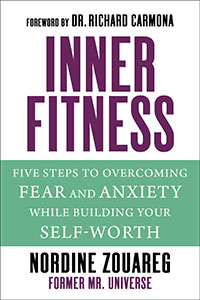By Nordine Zouareg | CONTRIBUTOR |
In one way or another, stress was a part of life before COVID-19, and it will remain a part of life after Covid-19. It is an integral and important part of your life, and it has a specific purpose. When you know how to use it to your advantage, managing and reducing stress becomes an important tool to attain higher performance and optimal health and well being.
One guaranteed way to increase stress is to stress about it. Just reading about its devastating health effects is enough to make you take note. We set unrealistic goals to be stress-free. Rather than eliminating stress, which is impossible and foolish, let’s focus on minimizing its harmful effects.
“ “We are not only well equipped to deal with daily stressors, but we can use our behavior to reduce the stress that is harmful” said Dr. Hans Selye, the 20th century’s leading authority on the subject of stress and its impact on human health.
Not all Stress is Bad: Distress vs. Eustress
Our susceptibility to stress varies and is not the same from person to person. An event that causes toxic stress in one person may not trigger it in another. Experiences must interact with a wide variety of background factors to create and manifest as an illness.
Among the factors that influenced the susceptibility to stress are genetic susceptibility, coping style, type of personality and social and environmental support. When we are facing a problem, we assess the seriousness of the problem and decide whether we have the resources necessary to cope with the problem. If we establish that the problem is serious enough and we do not have the resources necessary to cope with the problem, we will perceive ourselves as being under stress and will, therefore, trigger a physiological response such as sweating, increased heart rate, and increased blood pressure. It is our way of reacting to the situations that make a difference in our susceptibility to illness and our overall well-being. Research shows that resilience is the result of individuals being able to interact with their environments and the processes that either promote well-being or protect them against the overwhelming influence of risk factors.

Not all stress is bad. When the body uses stress to overcome fatigue or to enhance performance, the stress is positive, challenging and therefore healthy. Stress is good when it forces us to adapt and warns us if we are not coping well and if an immediate lifestyle change is necessary to maintain optimal health. This action-enhancing stress gave me, as an athlete, the competitive edge. This kind of stress is called eustress.
“ Stress is bad when the demand exceeds our ability to perform or cope.”
When stress creates fatigue and behavioral or physical issues, this harmful and toxic stress is called distress. Distress causes us to overreact, leads to confusion, poor concentration, and anxiety, resulting therefore in lower and bad performance.
The key is to recognize the good stress (eustress) from the bad stress (distress) and adapt to the one that serves you most. Aligning your life and living on purpose allows you to discover ways to adapt and identify what needs your attention and your energy most and address that instead of stressing about things that are not important to you.
Most people think of stress as an emotional state that occurs when you go through a negative situation, which is not true. Eustress or positive stress is short in duration, it’s exciting, and it motivates and energizes you. It brings opportunities for growth.
Distress or harmful stress lasts longer, creates fear, anxiety, and doubt, and it feels very unpleasant. It is a performance killer and has health consequences. Issues like financial problems, divorce, poor grades and bad arguments can be debilitating. The ability to cope with and manage stress can make a big difference in the quality of your life and will most likely help you live longer and happier. Because not everyone has the same reaction to particular events or situations, categorizing stressors into two lists of those that cause eustress and those that cause distress can be difficult. But we can still create a list of stressors identified by the general population as negative or positive.
Examples of eustress: Getting engaged or married, newborn baby, lottery gains, moving or buying a home, going on vacation, retiring, getting promoted or receiving a bonus or pay raise, participating in sport competitions (if you are ready), starting a new job, studying for a test (as long as you keep your eyes on the price and are not overwhelmed).
Examples of distress: Death of a loved one, divorce, job loss, illness, sleep issues, micro-management, bankruptcy of financial problems, conflicts in relationships, children poor performance at school, deadlines, overwhelming job demands, over scheduling, unscheduled or unproductive work meetings, negative colleagues or energy vampires, lack of job training or instructions, non- productive activities, separation from loved ones, phobias, negative thinking pattern, depression, unrealistic expectations.
| By Nordine Zouareg, Author of the book
InnerFitness |
 |
By Nordine Zouareg, Author of the book
InnerFitness
Five Steps to Overcoming Fear and Anxiety
While Building Your Self-Worth.’
Subscribe to get notifications about future articles.
About the Author: Nordine Zouareg – Contributor
Nordine Zouareg is the founder of Executive InnerFitness®, which for the past decade has helped thousands of overworked US Corporate Executives find work-life balance. As a former two-time Mr. Universe champion, an internationally acclaimed high-performance coach, fitness and wellness expert, author of the books Mind Over Body (Grand Central Publishing, 2007), and InnerFitness (SkyHorse Publishing, 2021), Nordine has made it his mission to provide effective and proven methods for maintaining both emotional and physical fitness. He has spent years understanding the unique pressures and stresses of working in high performance fields and has used his knowledge to help people tap into their ability for peak performance and ward off stress and emotional chaos. He draws on three decades of diverse experience in the fitness and wellness fields, including 10 years leading the revolutionary fitness program at Miraval Resort, the world-class destination spa in Tucson, Arizona.


